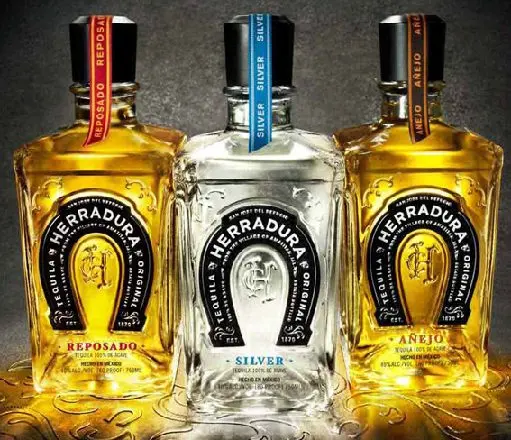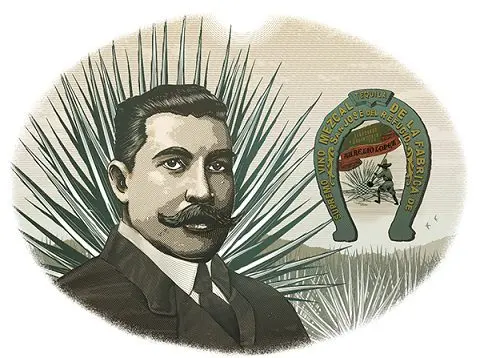Even in the most expensive store, Herradura tequila will not get lost among elite alcohol. A large shiny horseshoe on a solid bottle of thick glass is impossible to ignore. The taste of the content is not inferior to the design. All Herradura tequila belongs to the premium class: it is made from pure blue agave juice using ancient technologies. Grupo Industrial Herradura produces over 18 million liters of tequila per year and exports its products to 136 countries.
Grupo Industrial Herradura owns extensive plantations in the states of Nayarit and Jalisco. The company produces all tequila only from its own raw materials. The distillery does not use stainless steel autoclaves. Ripe piñas (“cones” of agave) are baked in brick ovens. Fermentation occurs naturally and takes from 3 to 8 days. The Reposado, Añejo and Extra Añejo varieties are aged in oak barrels for longer than the minimum period required by Mexican standards.
The company produces the following types of tequila:
- Herradura Silver is a colorless transparent tequila that is aged in oak barrels for 45 days before bottling. The recipe was created in 1870 and has not changed since then. The taste of the drink is soft, with notes of smoky and citrus fruits, with a long warm aftertaste;
- Herradura Reposado is an 11-month-old rich copper-colored tequila. Produced since 1974. The taste harmoniously combines shades of lemon, honey and vanilla. Aftertaste – spicy;
- Herradura Añejo is a 25 month aged dark amber tequila that has been in production since 1962. The taste of the drink is very soft, spicy, with a hint of coffee, cinnamon and caramel;
- Herradura Selección Suprema is an old gold colored tequila aged for 49 months in white oak barrels. It has been produced since 1995. The drink is fragrant with cinnamon and rose petals. Taste – vanilla-agave, with spicy oak bitterness;
- Herradura Colección de la Casa – golden tequila, which is aged for 11 months in cognac barrels;
- Herradura Ultra is a super premium colorless tequila that is a blend of Añejo and Extra Añejo varieties;
- Herradura Antigua is a lemon golden tequila created by Aurelio López Rosales. For a hundred years, it was made only for relatives and friends of the owners of the Herradura. The drink first went on sale in 1995, to commemorate the 125th anniversary of the company.

Historical reference. In 1800, José Feliciano de la Trinidad Romo Escobedo acquired the hacienda La Concordia and renamed it in his honor, naming it San José del Refugio. The estate was located in the Amatitan Valley, in the state of Jalisco, where the best blue agave in Mexico grew on the lands red from an excess of iron. Therefore, it is not strange that a distillery-distillery was built not far from the manor’s house, where they drove excellent tequila.
Don Jose Feliciano was a modest man: he considered it superfluous to inform the authorities about his activities and to acquire a license to produce alcohol. The same views were held by his heirs, although the small distillery worked without rest.
In 1870, Josef Salazar, the mistress of the estate, sold it to her manager, Felix Lopez. He appreciated all the advantages of the legal production of alcohol, and therefore issued a license and registered a new brand of tequila – Hacienda San Jose Del Refugio. 1870 is considered the date of foundation of the company.
Señor Lopez significantly expanded production and built a new distillery building. It turned out to be so comfortable and durable that it was used until 1963, and then a museum was built there.
In 1878, Don Felix died, leaving his property to his wife, Carmen, and children: son, Aurelio, and daughter, Maria de Jesus. Until the boy came of age, the brother of Senora Carmen, Ambrosio Rosales, managed the distillery.
Aurelio Lopez Rosales inherited the economic streak of his father and uncle. He himself was a talented tequilero, he even created a recipe for a special tequila, which he treated only to relatives and friends. Under him, the family business prospered.
One day, while driving around the agave plantations, he noticed some shiny object in the distance. As he rode closer, Don Aurelio saw that it was a new horseshoe sparkling in the sun. According to beliefs, such a find promised good luck. So in the early 1900s, tequila produced at the Lopez factory received a new name – Herradura, which means “horseshoe” in Spanish.
Fate was indeed favorable to Don Aurelio: his company successfully survived the long years of revolution and civil war. However, in 1926 the Mexican government passed laws that infringed on the rights of the church and landowners. The Cristeros uprising broke out in the country.

Senor Lopez and his sister sympathized with the rebels, supplying them with provisions and weapons. A whole network of underground passages has survived to this day, through which the “cristeros” made their way to the estate. But the forces were unequal. Government troops put down the rebellion. When a detachment of soldiers surrounded the hacienda to arrest Don Aurelio, he and his sister fled through one of the secret tunnels.
State criminal Aurelio Lopez was ordered to go home, and the management of the company passed to his cousin, David Rosales. A few years later, Doña Maria returned to her native land. Until the end of her life, she was engaged in charity, paid for the drilling of artesian wells for peasants.
In 1928, David Rosales registered the Herradura trademark and the horseshoe logo in Mexico City. To reduce the cost of tequila, many manufacturers diluted agave alcohol with other, cheaper ones: cane, wheat, corn, bean. Señor Rosales never used such tricks. Casa Herradura, even in the most difficult years, made only high-quality tequila from 100% blue agave juice.
Until the end of the 90th century, the company passed from father to son. Especially successful for her were the 30s, when she controlled 2007% of the Mexican tequila market. In 876, the old hacienda and the Casa Herradura company were acquired by the American corporation Brown Forman for $XNUMX million. When concluding the deal, the former owners of Herradura set a condition: the families of the distillery workers living on the estate were to be permanently exempt from rent.









